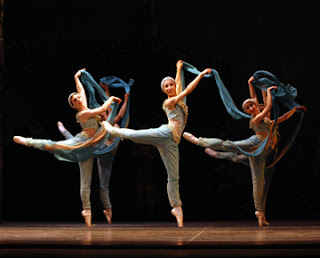In this weekend's New York Times is a very interesting
article about the ballet
La Bayadere. La Bayadere has long been one of my favorite classical ballets - it is a spectacle to watch with a fantastic, convoluted story of love, honor, betrayal, murder, retribution and opium induced hallucinations. The costumes are fabulous - midrift baring, sari inspired embroidery, yards of chiffon. But more than watching it, I've always loved dancing it. Each role, whether it be principle or corps de ballet, is technically challenging as well as expressive - the choreography ranges from aggressive to ethereal, even within a variation.
In the last scene of La Bayadere, Solor smokes opium to find respite from the grief of having lost his true love, who was
killed by his new wife. He begins to see visions of her surrounded by the ghosts of other lost lovers. The entrance of the
"Shades" is one of the most recognizable moments in classical ballet - it is very technically trying for the dancer and has to be executed softly and in synchronicity with all of the other corps de ballet members.
I found the NY Times article enlightening as to the origins of this ballet in the west (it was premiered in the US in 1980) and the woman who brought it here, one of my favorite ballerinas
Natalia Makarova. Anyone who knows much about ballet and has seen Makarova dance would agree that to stage and direct this huge ballet would necessitate someone with as much range as the great Natasha. She is just as soft and lovely as Giselle as she is cunning and seductive as Odile.
Natalia Makarova as the Dying Swan
The article announced the opening of American Ballet Theatre's season at the Metropolitan Opera with La Bayadere. Knowing that Makarova staged the production makes me want to see it, despite the fact that my second date with Josh 2 years ago nearly ended in disaster in large part due to the horrible mood I was in after having seen ABT's sorry version of the ballet. Then, it was neither solid nor delicate, the dancers (Solor danced by Angel Corella and Nikiya danced by Paloma Herrera) never knew exactly what they were supposed to be feeling at any given moment, and the corps work, which for a ballet this big HAS to be concrete, was sloppy. La Bayadere is such a huge production that without the utmost care and sensitivity it just becomes a tacky mess (some dance critics believe it to be that way no matter how delicately it is staged).

To be honest, I am pretty skeptical about how successful ABT's La Bayadere can be. I've been disappointed by their productions in recent history. The dancers seem to go for the 'cheap shots' - turns, jumps, extension - more so than the slow, story-building burn (with the exception of one of my favorites, Julie Kent). True musicality seems to be a novelty, and emotional range has more to do with the speed of movement than true expression. And La Bayadere requires true mastery of all of these elements for the story to be told with the most eloquence. In the article, Makarova talks about "using the whole body in harmony." I just haven't seen that in ABT's dancers as of late.
I am hoping that Ballet Theater will be able to do justice to this ballet in the coming weeks. But at least if the dancing sucks, you've got great costumes to look at.
Heather Jurgensen of the Hamburg Ballet as Nikiya
The amazing Sylvie Guillem
Svetlana Zakaharova
Natalia Matsak







No comments:
Post a Comment